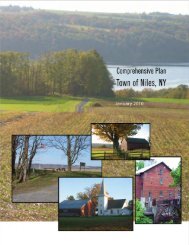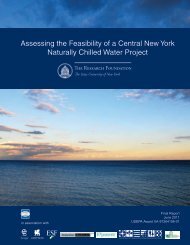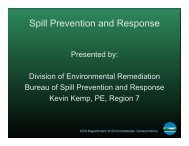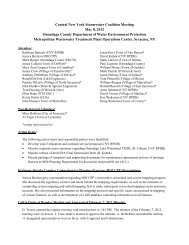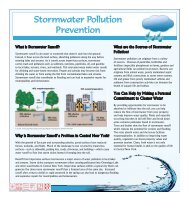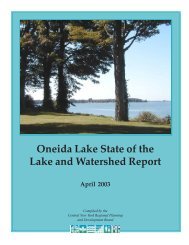A Management Strategy for Oneida Lake and its ... - CNY RPDB Home
A Management Strategy for Oneida Lake and its ... - CNY RPDB Home
A Management Strategy for Oneida Lake and its ... - CNY RPDB Home
You also want an ePaper? Increase the reach of your titles
YUMPU automatically turns print PDFs into web optimized ePapers that Google loves.
Flood Definitions<br />
Flood: “A great flowing or overflowing of water, especially over l<strong>and</strong> not usually submerged.”<br />
(The R<strong>and</strong>om House College Dictionary).<br />
A “flood”, as defined by the National Flood Insurance Program (NFIP) by the Federal Emergency<br />
<strong>Management</strong> Agency (FEMA) is, "a general <strong>and</strong> temporary condition of partial or complete<br />
inundation of two or more acres of normally dry l<strong>and</strong> area or of two or more properties (at<br />
least one of which is your property) from overflow of inl<strong>and</strong> or tidal waters, unusual <strong>and</strong> rapid<br />
accumulation or runoff of surface waters from any source, or a mudflow.<br />
[The] collapse or subsidence of l<strong>and</strong> along the shore of a lake or similar body of water as a result<br />
of erosion or undermining caused by waves or currents of water exceeding anticipated cyclical<br />
levels that result in a flood."<br />
Major flood: “A general term indicating high water that causes extensive inundation <strong>and</strong><br />
property damage, usually characterized by evacuation of people <strong>and</strong> animals <strong>and</strong> closure of<br />
highways.” (U.S. Army Corps of Engineers (ACOE)<br />
Nuisance High Water: Water above “normal levels” that may temporarily impact docks,<br />
seawalls, shorelines, lawns <strong>and</strong> roads in low-lying shoreline areas but that does not cause structural<br />
damage to homes <strong>and</strong> businesses.<br />
Minor Flooding: Flooding above “Nuisance High Water” at which structural damage may<br />
occur but that does not represent a serious threat to life or substantial commercial or residential<br />
damage. Flooding in this category may enter into some residential <strong>and</strong> commercial structures<br />
<strong>and</strong> basements with very limited structural damage. This flooding may also result in closure of<br />
some roads <strong>and</strong> require the rerouting of traffic. Further, minor flooding may have temporary<br />
impacts on in ground septic systems, wells, electrical supplies, <strong>and</strong> HVAC systems. This level<br />
of flooding would trigger a response from county <strong>and</strong> local emergency managers.<br />
* Minor flooding begins at elevation: 371.0 feet (ACOE “Level where flooding begins”).<br />
Major Flooding: Flooding that has a high potential <strong>for</strong> loss of life <strong>and</strong> total property loss.<br />
Water levels that are sufficiently high to enter into a large percentage of shoreline residential <strong>and</strong><br />
commercial structures <strong>and</strong> result in considerable structural damage. Major flooding would<br />
trigger a response from the full breath of emergency response agencies, including but not limited<br />
to FEMA, ACOE, New York State Emergency <strong>Management</strong> Office (SEMO), <strong>and</strong> county <strong>and</strong><br />
local emergency managers.<br />
* Major flooding begins at elevation: 372.4 feet (ACOE Major Flood Damage Level).<br />
The terms “Nuisance”, “Minor” <strong>and</strong> “Major” flooding are derived from a basin-wide planning<br />
perspective (big picture) <strong>and</strong> not from the individual property owner perspective. It is understood<br />
that even minor flooding can be a catastrophe to individual property owners.<br />
Appendices page 93



